1993 BUICK CENTURY light
[x] Cancel search: lightPage 131 of 324

Disabling the Anti-Theft System:
1. Press the 1 and 4 buttons together for five seconds
with ignition on and radio power off. The display will
show
SEC, indicating the unit is in the secure mode.
2. Press the SET button. The display will show 0o0.
3. Enter the first three digits of the code following step 6
of the preceding paragraphs. The display will show the
numbers as entered.
4. Press the lower (BAND) knob. The radio will display
OOO.
5. Enter the second three digits of the code. The display
will show the numbers as entered.
6. Press the lower (BAND) knob. If the display shows
‘‘- - - ,” the disabling sequence was successful (the
numbers matched the user-selected code or the factory
back-up code) and the unit is in the
UNSECURED
mode. If the display shows SEC, the disabling
sequence was unsuccessful and the numbers did not
match either. of the codes and the unit will remain in
the
SECURED mode.
Care of Your Cassette Tape Player
A tape player that is not cleaned regularly can cause
reduced sound quality, ruined cassettes, or a damaged
mechanism. Cassette tapes should be stored
in their cases
away from contaminants, direct sunlight, and extreme
heat. If they aren’t, they may not operate properly or
cause failure
of the tape player.
Your tape player should be cleaned regularly each month or after every
15 hours of use. If you notice a reduction in
sound quality,
try a known good cassette to see if the tape
or the tape player is at fault. If this other cassette has n\
o
improvement in sound quality, clean the tape player.
1 /.Y
ProCarManuals.com
Page 132 of 324
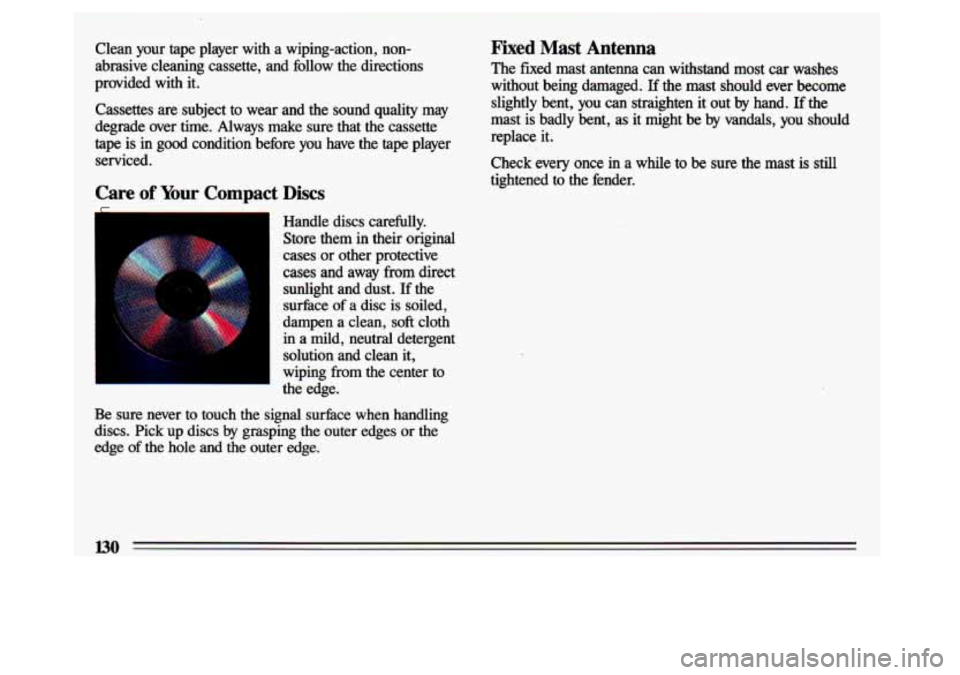
Clean your tape player with a wiping-action, non-
abrasive cleaning cassette, and follow the directions
provided with it.
Cassettes are subject to wear and the sound quality may
degrade over time. Always make sure that the cassette
tape is in good condition before you have the tape player
serviced.
Care of Your Compact Discs
Fixed Mast Antenna
The fixed mast antenna can withstand most car washes
without being damaged.
If the mast should ever become
slightly bent, you can straighten it out
by hand. If the
mast is badly bent, as it might be
by vandals, you should
replace it.
Check every once
in a while to be sure the mast is still
tightened to the fender.
Handle discs carefully. Store them
in their original
cases or other protective
cases and away from direct sunlight and dust. If the
surface of a disc is soiled,
dampen a clean,
soft cloth
in a mild, neutral detergent
solution and clean it,
wiping from the center to
the edge.
Be sure never to touch the signal surface when handling
discs. Pick up discs
by grasping the outer edges or the
edge of the hole
and the outer edge.
130
ProCarManuals.com
Page 142 of 324
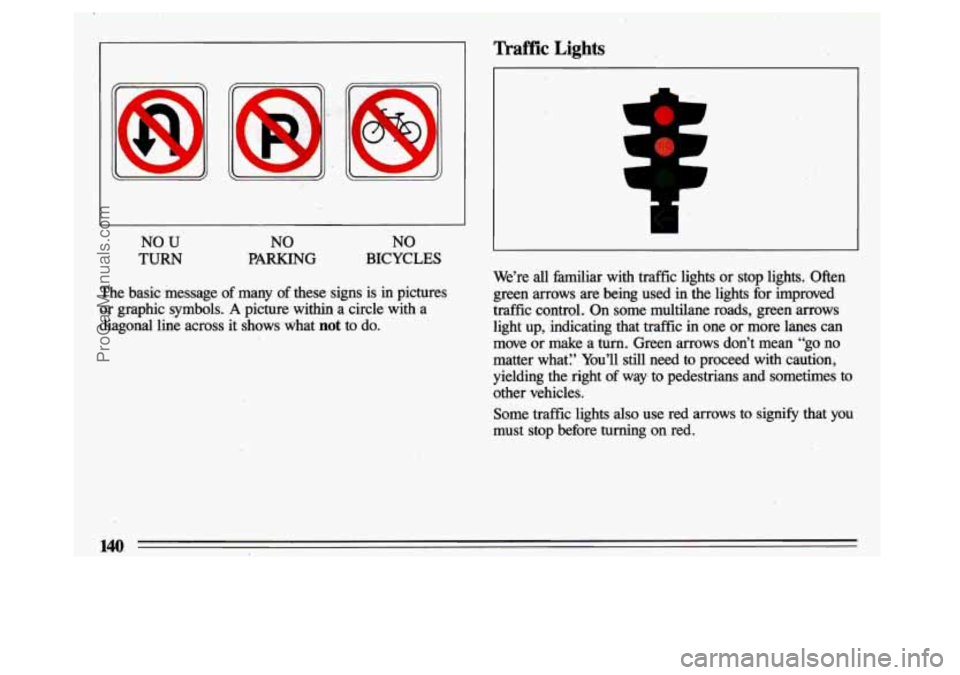
NO U’ NO NO
TURN PARKTNG BICYCLES
The basic message of many of these signs is in pictures
or graphic symbols.
A picture within a circle with a
diagonal line across it shows what not to do.
Traffic Lights
We’re all familiar with traffic rights or stop lights. Often
green arrows are being used in the lights for improved
traffic control. On some multilane roads, green arrows
light up, indicating that traffic in one or more lanes can
move or make a turn. Green arrows don’t mean “go no
matter what? You’ll still need to proceed with caution,
yielding the right of way to pedestrians and sometimes to
other vehicles.
Some traffic lights also use red
arrows to signify that you I
must stop before turning on red.
ProCarManuals.com
Page 143 of 324
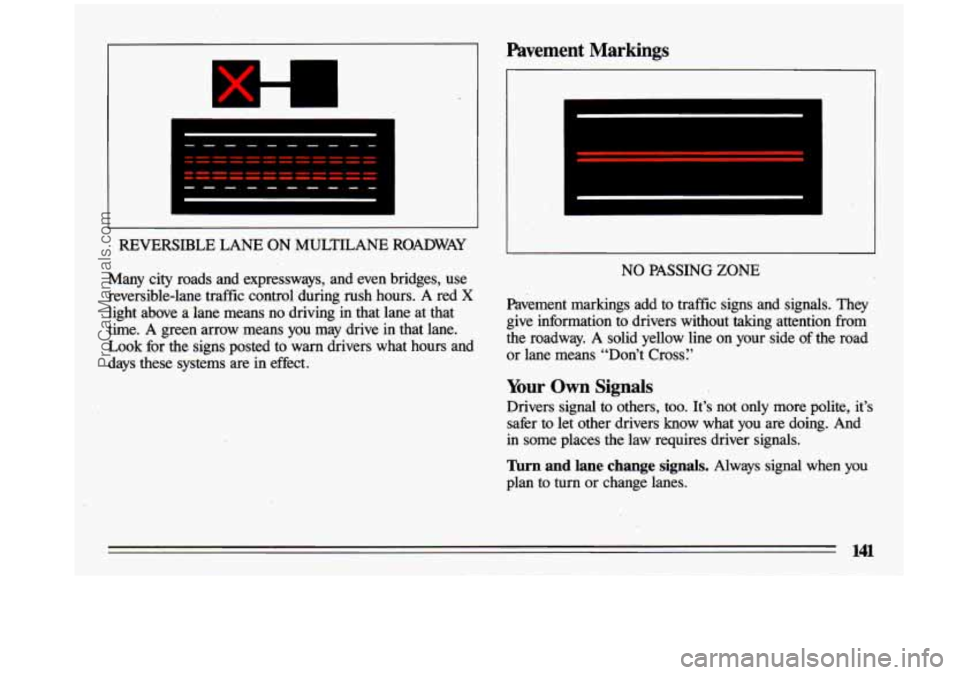
x
I I
REVERSIBLE LANE ON MULTILANE ROADWAY
Many city roads and expressways, and even bridges, use
reversible-lane traffic control during rush hours. A red
X
light above a lane means no driving in that lane at that
time. A green arrow means you may drive in that lane.
Look for the signs posted to warn drivers what hours and
days these systems are in effect.
Pavement Markings
NO PASSING ZONE
Pavement markings add to traffic signs and signals. They
give information to drivers without taking attention from
the roadway. A solid yellow line on your side
of the road
or lane means “Don’t Cross:’
Your Own Signals
Drivers signal to others, too. It’s not only more polite, it’s
safer to let other drivers know what you are doing. And
in some places the law requires driver signals.
Turn and lane change signals. Always signal when you
plan to turn or change lanes.
141
ProCarManuals.com
Page 144 of 324

If necessary, you can use hand signals out the window:
Left arm straight out for a left turn, down for slow or
about-to-stop, and up
for a right turn.
Slowing down. If time allows, tap the brake pedal once
or twice in advance of slowing
or stopping. This warns
the driver behind you.
Disabled. Your four-way flashers signal that your vehicle
is disabled or is a hazard.
See “Hazard Warning
Flashers’’ in the Index.
Traffic Officer
The traffic police officer is also a source of important
information. The officer’s signals govern, no matter what
the traffic lights or other signs say.
The next section discusses some
of the road conditions
you may encounter.
Defensive Driving
The best advice anyone can give about driving is: Drive
defensively.
Please
start with a very important sakty device in your Buick:
Buckle up.
(See “Safety Belts” in the Index.)
Defensive driving really means “be ready for anything:’
On city streets, rural roads, or freeways, it means
“always expect the unexpected:’ Assume that pedestrians
or other drivers are going to be
careless and make mistakes. Anticipate what they might
do. Be ready for their mistakes.
Expect children to dash out from behind parked cars,
often followed by other children. Expect occupants in
parked cars to open doors into traffic. Watch for movement
in parked cars-someone may be about to open
a door.
Expect other drivers to run stop signs when you are on a
through street. Be ready to brake
if necessary as you go
through intersections. You may not have to use the brake,
but if you do, you will be ready.
If you’re driving through a shopping center parking lot
where there are well-marked lanes, directional mows,
and designated parking areas, expect some drivers to
ignore
all these markings and dash straight toward one
part of the lot.
Pedestrians can be careless. Watch for them. In general,
you must give way to pedestrians even if you
know you
have the right of way.
Rear-end collisions
are about the most preventable of
accidents. Yet they are common. Allow enough following
distance. It’s the best defensive driving maneuver, in both
city and rural driving. You never know when the vehicle
in front of you is going
to brake or turn suddenly.
Here’s a final bit of information about defensive driving.
The most dangerous time for driving in the
U.S. is very
142
ProCarManuals.com
Page 146 of 324
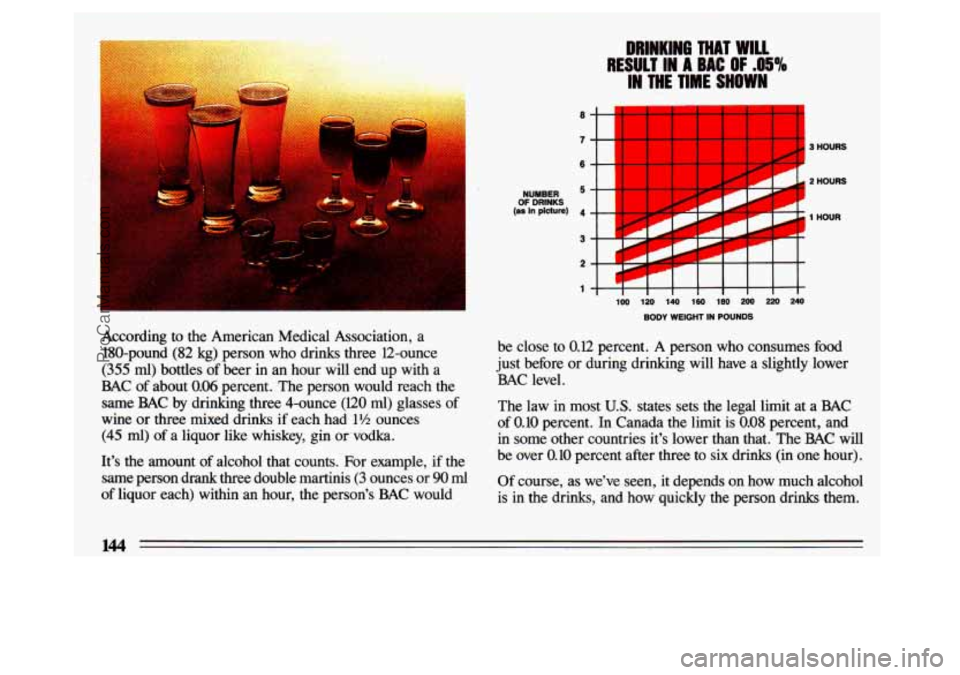
According to the American Medical Association, a
18O-pound’(82 kg) person who drinks three 12-ounce
(355 ml) bottles of beer in an hour will end up with a
BAC of about 0.06 percent. The person would reach the
same BAC
by drinking three 4-ounce (120 ml) glasses of
wine or three mixed drinks if each had
1% ounces
(45
ml) of a liquor like whiskey, gin or.vodka.
It’s the amount of alcohol that counts. For example,
if the
same person
drank three double martinis (3 ounces or 90 ml
of liquor each) within an hour, the person’s BAC would
DRINKING THAT WILL
RESULT IN A BAC OF .05%
IN THE TIME SHOWN
OF DRINKS
NUMBER (as in picture) 4
I HOURS
IFglT 1 &
100 120 140 160 1ao 200 220 240
BODY WEIGHT IN POUNDS
be close to 0.12 percent. A person who consumes food
just
before or during drinking will have a slightly lower
BAC level.
The law in most
U.S. states sets the legal limit at a BAC
of 0.10 percent. In Canada the limit
is 0.08 percent., and
in some other countries it’s lower than that. The BAC will
be over
0.10 percent after three to six drinks (in one hour).
Of course, as we’ve seen, it depends on how much alcohol
is in the drinks, and how quickly the person drinks them.
144
ProCarManuals.com
Page 149 of 324
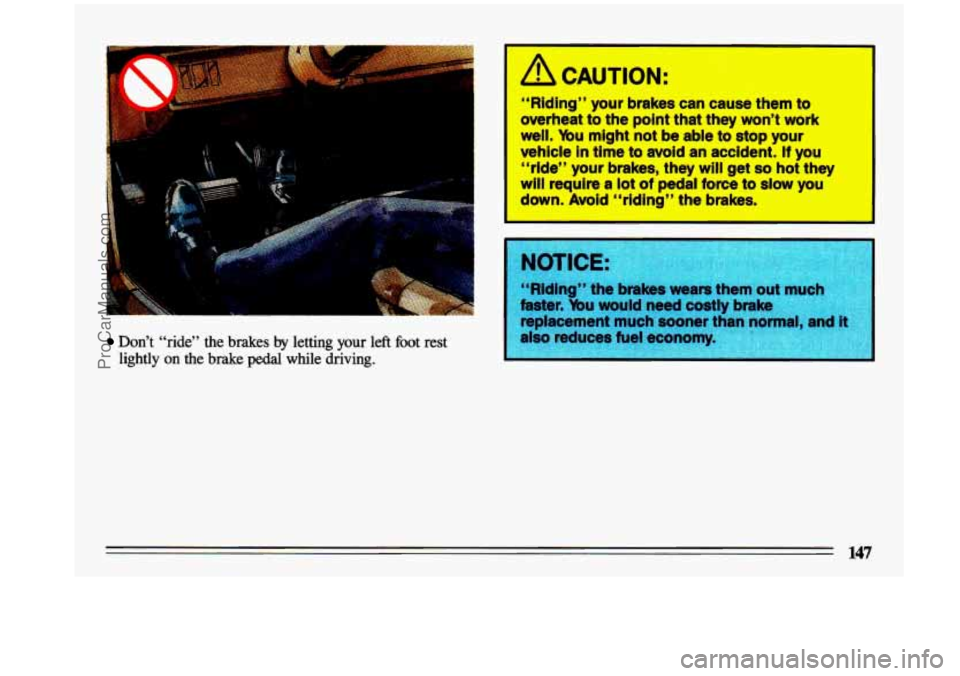
Don’t “ride” the brakes by letting your left foot rest
lightly
on the brake pedal while driving.
“Riding” your brakes can cause them to
overheat to the pointthat they won’t work
well. Mu might not be able to stop your
vehicle In tlme to avoid an accident. If you
6crlde” your brakes, they will get 80 hot they
will require a lot of pedal force to slow you
down. Avold “ridlng” the hralaas.
faster. vou would need cos
replacement
much sooner
also reduces fuel economy.
147
ProCarManuals.com
Page 150 of 324
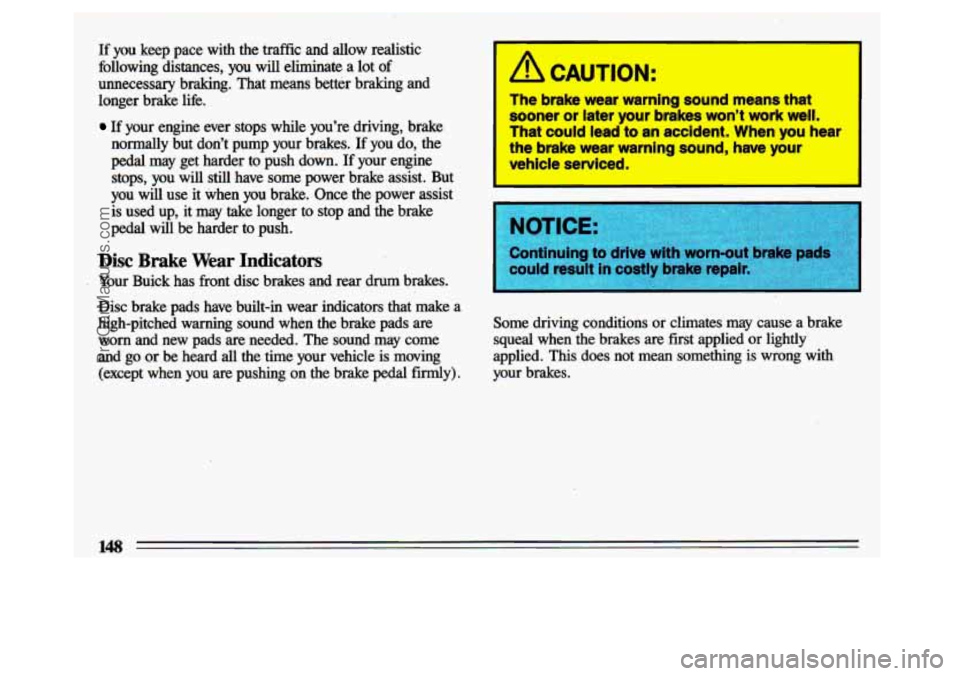
If you keep pace with the traffic and allow realistic
following distances, you
will eliminate a lot of
unnecessary braking. That means better braking and
longer brake life.
If your engine ever stops while you're driving, brake
normally but don't pump your brakes. If you do, the
pedal may get harder
to push down. If your engine
stops, you will still have some power brake assist. But
you will use it when
you brake. Once the power assist
is used up, it may take longer to stop and the brake
pedal will be harder to push.
Disc Brake Wear Indicators
Your Buick has front disc brakes and rear drum brakes.
I A CAUTION:
The brake wear wamlng sound means that
sooner or later pur brakes won't work well.
That could lead to an accident. When you hear
the brake wear warning sound, have your
vehlcle serviced.
I
Disc brake pads have built-in wear indicators that make a
high-pitched warning sound when the brake pads are Some driving conditions or climates may cause a brake
worn and new pads
are needed. The sound may come squeal when the brakes are first applied or lightly
and
go or be heard all the time your vehicle is moving applied. This do\
es not mean something is wrong with
(except when you are pushing on the brake pedal firmly). your brakes.
ProCarManuals.com